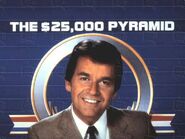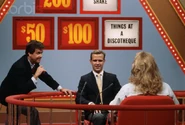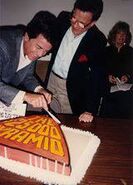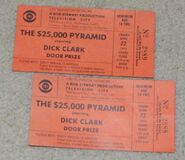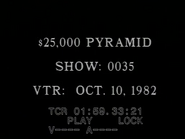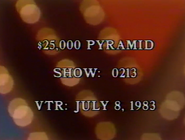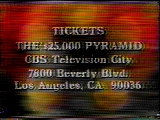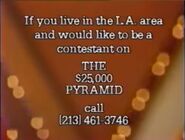| Aired | |
| CBS Daytime, September 20, 1982 - December 31, 1987; April 4, 1988 - July 1, 1988 | |
| Number of episodes | |
| 1,403 | |
| Run time | |
| 30 minutes | |
| Host | |
| Dick Clark | |
| Announcer | |
| Jack Clark (1982-1985) Johnny Gilbert (Sub from 1982-1985; permanent from 1986-1988) | |
| Origination | |
| CBS Television City Hollywood, California | |
This is chronicling the 1980s series of The $25,000 Pyramid.
Game Format[]
Main Game[]
Two teams, each consisting of a celebrity guest and a studio contestant, attempted to guess a series of items relating to different categories within a short time limit based on clues given by their partners.
The show's title referred to its pyramid-shaped game boards, both in the main game and in the Winner's Circle, featuring six categories arranged in a triangular fashion. As always in the main game, each category's title was cleverly written in order to give team members a vague idea of what it was about (ex: "Loosen Up" - things that are stiff; "Made Public" - things that are used by the public; "The Woodsman" - things that a carpenter uses). Some categories also involved famous people, which contestants and celebrities both dreaded. Each team played each category in alternating order (their choice), and for each category, one person on the team had 30 seconds to describe seven items relating to that category to their partner. Teams scored 1 point for each correct answer (for a maximum of 7 points); if they passed on a word, they could not come back to it, but if the receiver guessed it right after it was passed, the team still earned a point for it. The clue giver could use voice inflections and hand/body movements while describing a word, but they could not say the actual word or any other part of it or else they would lose out on that potential point score (accompanied by a "cuckoo" sound effect). For the first two categories, the celebrities gave the clues, then the contestants gave the clues for the next two, and then for the final two, teams decided amongst themselves who would give or receive clues (the team that was trailing usually got first pick between the last two categories). The team in the lead after the sixth category moved on to the Winner's Circle.
Bonus Cards[]
In each half of the show, there was a bonus card hidden behind one of the six categories on a board and for the team that uncovered it, the contestant partner had a chance to win either bonus money or a bonus prize which would be theirs to keep whether they won the game or not. Of course, to win the bonus, the team had to get all 7 answers right. In situations where a team didn't all 7 points to win on the very last category or they won the game automatically, if the very last category concealed the bonus card, the team was allowed to play the category all the way out to try and win the bonus prize.
- 7-11 - Premiering on April 11, 1983, the 7-11 was played in the first game; if the team that selected the category with this bonus card got all 7 answers right within 30 seconds, the contestant partner won an $1,100 bonus. Originally, contestants could either go all-for-nothing and play for the $1,100 or go for the sure thing and play the category at $50 for each correct answer, but this option was dropped effective January 21, 1985. For the four all-star celebrity tournaments in 1987, the 7-11 was played in each half of the show.
- Mystery 7 - Featured in the second game, the Mystery 7 was on the show for its entire run. The Mystery 7 was named as such because the team that played it was not told what the category was about until it was done and over with, regardless of whether the contestant partner had won the bonus prize or not. Originally, the Mystery 7 was presented in plain sight as the bottom right category on the game board, but because it was often chosen outright at the beginning of the second game, it was hidden behind one the six categories effective April 23, 1984.
Tiebreaker[]
If both teams were tied at the end of the sixth category, then their scoreboards were wiped clean and the tiebreaker game commenced (originally it was played as a separate segment, but effective September 5, 1983, it was played immediately after the sixth category). One member of each team was to describe a series of seven words all beginning with the same letter of the alphabet to their partner in the fastest time possible. The team that caused the tie got first choice between two sets of words each beginning with different letters; however long it took them to complete that set was the time limit that the opposing team had to complete theirs in order to break the tie and win. The team that got the most out of seven won the game. From January 16, 1984 to October 19, 1984, if a game ended in a perfect tie (21-21), then the contestant partner of the tiebreaking team won a new car. Beginning October 22, 1984, contestants who won 21-21 tiebreakers won $5,000 in cash (like the $1,100 from the 7-11, contestants who won this bonus got to keep it whether they won the game or not).
Player of the Week[]
For three weeks in 1983 (February 7 - February 25), the player who had the fastest time of the week won a trip to Greece. During this period, the Mystery 7 was not played.
Winner's Circle[]
The Winner's Circle was still played the same way as before: one member of the winning team had 60 seconds to describe six categories of increasing difficulty to their partner by listing items relating to each category. Contestants always had the option of whether they wanted to give or receive clues in the Winner's Circle, but celebrities usually gave the majority of the time. Regardless of who gave the clues, there were strict rules involving the types of clues players could not give in the Winner's Circle (see below):
- Clue givers could not use their hands (their chair had special straps attached to the arms to prevent them from doing so)
- Clue givers could not give away any part of the category itself or the essence thereof
- Clue givers had to use a short and concise list of clues; they could not use clues that were overly descriptive
- Clue givers could not use synonyms or prepositional phrases
- Clue givers' clues had to relate to the category itself
If the clue giver gave an illegal clue at any time, the category in play was thrown out, thus disqualifying the contestant from winning the grand prize. However, if this happened with time left on the clock and with unrevealed categories yet to be played, then the team was allowed to play the remainder of the Winner's Circle until time ran out or until the remaining categories were all correctly guessed. The first category was worth $50, and each subsequent category was worth $50 more, up to $300 for the sixth. If the team got all six right before the time expired, then the contestant partner won the grand prize.
Whichever contestant made it to the Winner's Circle in the first half of the show played for $10,000, if they won then the second Winner's Circle was worth $15,000, but if they won a lesser amount in the first, winning the second Winner's Circle would augment their winnings to $25,000. If both contestants made it to the Winner's Circle in each half of the show, then they each played it for $10,000.
Only the monies scored in the Winner's Circle determined who won the game (bonus monies from the 7-11 and 21-21 tiebreakers did not count). If the same contestant made it to the Winner's Circle twice in one show, then he/she won and returned on the next show. If both contestants made it to the Winner's Circle in each half of the show, then the one who won the most money there won the game. If they both tied each other in that same scenario, including $10,000 wins, then they both got to return on the next show.
Contestants were allowed to remain on the show until they were defeated, until they won five days in a row, or until they exceeded CBS's cap winnings limit, whichever came first (any contestant who exceeded this limit and/or won five days in a row was retired). Originally the limit was $25,000, but it was doubled to $50,000 on October 22, 1984, and then it was increased again to $75,000 on September 29, 1986. Contestants were allowed to keep a maximum of $25,000 in excess of the limit. Only four players won over $50,000 on this version. They were Mari Nicotera with $50,050 on April 16, 1985, Kathy O'Brien with $56,950 on May 30, 1985, Barbara Schnell with $58,950 on February 3, 1986, and Kelly Grogan with $60,050 on June 30, 1988.
Trivia[]
Effective November 8, 1982, The $25,000 Pyramid was retitled as The New $25,000 Pyramid so that viewers wouldn't get it confused with the original 1974-79 series, which at the time was being rerun in syndication. The title returned to its original on January 28, 1985.
Jack Clark was the original announcer, with Johnny Gilbert, Jerry Bishop, Rod Roddy, Charlie O'Donnell, Bob Hilton, and Charlie Tuna filling for him on occasion. He left in 1985, and after three months of rotating different announcers, Gilbert officially succeeded him in 1986.
Merchandise[]
Board Games[]
Cardinal (1986)[]
For this version you were allowed to play both the $25,000 and $100,000 Pyramid featuring Dick Clark on the cover.
Endless Games (2000)[]
A newer version was released featuring the old Game Show Network logo on the box cover.
Video Slot Machine[]
IGT/International Game Technologies (2001)[]
A slot machine game based on this version was released feauring Dick Clark.
Brochure[]
The $25,000 Pyramid Video Slots (circa 2001)
Photos[]
Promo Slide[]
Article[]
Print Ads[]
Photos[]
Tickets[]
Slates[]
Ticket Plugs[]
Contestant Plug[]
Press[]
Episode Status[]
Reruns aired on USA Network from October 17, 1988 to November 4, 1994, and on again, off again on GSN (now Game Show Network) since October 11, 1997.
GSN said in an e-mail in 1997 that they have the entire respective runs of both 80's Pyramid incarnations. In spite of this statement, however, GSN did not rerun the full CBS Daytime version. Only September 20, 1982-November 7, 1983, May 6, 1985-April 22, 1987, and October 19, 1987-July 1, 1988 (including September 21-25, 1987) were rerun. November 8, 1983-May 3, 1985 (including 1984) and April 23-October 16, 1987 (excluding September 21-25, 1987) did not rerun.
See Also: The New $25,000/$100,000 Pyramid/Episode Guide
The New $25,000/$100,000 Pyramid/USA reruns
See Also[]
The $10,000 Pyramid
The $20,000 Pyramid
The $25,000 Pyramid
The $25,000 Pyramid (2010)
The $50,000 Pyramid
The $100,000 Pyramid
The $100,000 Pyramid (1991)
The $100,000 Pyramid (2000)
The $100,000 Pyramid (2016)
The $500,000 Pyramid
The $1,000,000 Pyramid (2000)
The $1,000,000 Pyramid (2009)
Pyramid (1996)
Pyramid (1997)
Pyramid (2002)
The Pyramid (2012)
Pyramid Rocks
The Junior Pyramid
Junior Partner Pyramid
All-Star Junior Pyramid









